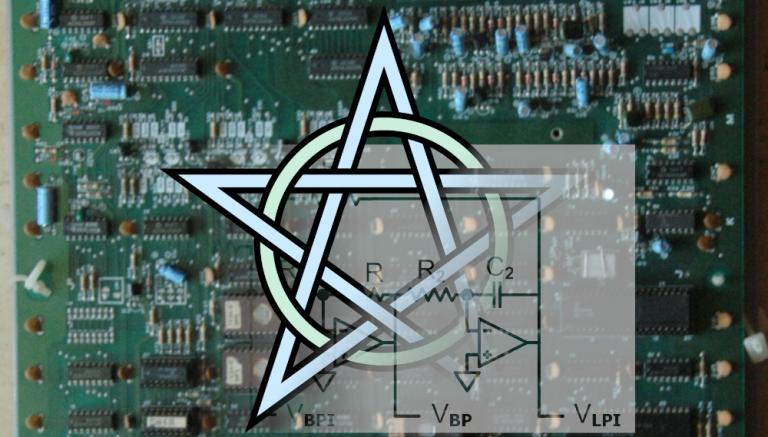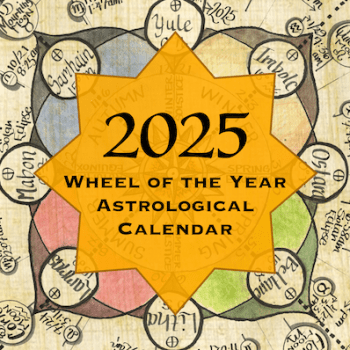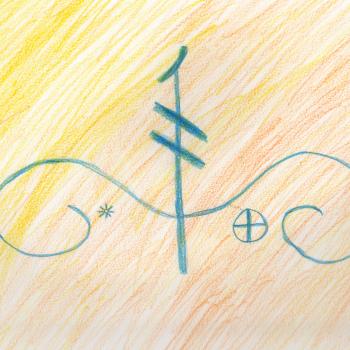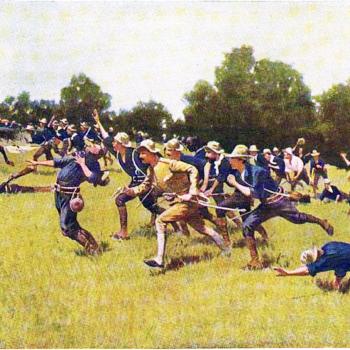I recently gave a talk on “Technopaganism” at the Winterstar Symposium, held via Zoom. These are my notes, or you can watch/listen to the video.
Hi! For those how don’t know me, I’m Tom Swiss. I blog on the Patheos Pagan channel as “The Zen Pagan”, and I’m the author of Why Buddha Touched the Earth. And I just self-published a booklet, Punk Magick, expanded from the talk I gave last year at Winterstar. You can find those books at infamous.net/books.
But as you might guess, publishing low-selling Pagan books and occasional blogging doesn’t pay the bills.
So I mostly make my living as a software developer and systems administrator — Linux, PHP, C++, Javascript, that sort of stuff. And I came up in that early on-line culture: I was on FidoNET BBSes in the late 1980s, then USENET; I wrote my first HTML in 1993, and have had my infamous.net domain since 1997. I have a user id on Slashdot that’s under 50,000, which used to mean something to some people…
In short, I was a “hacker” back when we still argued that that meant “A person who delights in having an intimate understanding of the internal workings of a system, computers and computer networks in particular”[Malkin & LaQuey Parker] rather than a computer criminal.
And there are some interesting connections between that “hacker community” and the way Paganism developed in developed on-line and in “meatspace” during those years, that have left some impact today.
Now I’ve been presenting talks and workshops at various events for a while, and sometimes it’s a matter of “hey, here’s a thing that I know a fair amount about and I’m going to talk about it”.
But sometimes it’s a matter of “hey, here’s a thing I wonder about, so I’m going to research it a little and then talk to you folks about it and see what you think.” That’s more the plan today. If I do this right the last 15-20 minutes will be open discussion.
What I’d like to do here is, as a 50-something computer guy, maybe a little bit of cultural transmission, if any of you all work in software or IT and are younger than me.
For those who aren’t technologists, I hope the history and general ideas I’m going to talk about will be interesting, and might suggest ways to draw on technology to enhance our Paganism and vice-versa.
Our friend Ian Corrigan mentioned yesterday how ritual magic imitates technology. Consider the discovery of fire: our distant ancestors learned to make fire to keep warm and cook food, and then said “hey, this is really cool, let’s use it in ritual.”
Another example is how literacy has been imitated by the non-literate. Spirit rapping followed the invention of the telegraph. From crystal radios, to crystals on your altar. I know one teacher who models energy shields after an internet firewall, dropping unwanted packets.
OTOH, let’s beware quantum woo, where we confuse metaphors grounded in science or technology, with the what science actually works. We don’t want a cargo cult.
Big Picture History
I actually want to start with some broad historical context around technology and Paganism. That’s kind of my thing, backing way off to get that view from 100,000 feet.
This is a guiding idea in a lot of my work over the past ten or fifteen years, some of you may have heard me talk about it before: that the whole Pagan revival, going back to the eighteenth and nineteenth centuries, is a response to the social changes that came out of the Industrial Revolution.
This is rooted in idea from Joseph Campbell’s essay “The Symbol without Meaning”.
Let’s go way way back, into prehistory, before writing, to paleolithic gatherer-hunter societies. These were fairly flat, where oral tradition and word-of-mouth was sufficient to keep things organized. And religion in those gatherer-hunter cultures was sort of straightforward, more about direct experience.
Of course we’re generalizing wildly here, but if you’ll grant that, we see an interesting pattern. In these paleolithic early societies everyone did a little of everything.
If you grabbed a fifteen-year-old boy out of a hypothetical composite pre-agricultural tribe, he’d be somewhat competent at every aspect of its culture and technology, at least those available to its males.[Campbell 142-144] He might not be the best at tracking game, but he can usually follow a deer. He might not be the best at chipping an arrowhead, but he can make a serviceable one. He might not be the best at finding medicinal herbs, but he knows what leaves to chew if he’s got a stomach ache.
And he might not be the best at going into a visionary, mystical state of consciousness — that person would be the local shaman. But he’s had such experiences — maybe he went on a vision quest type of experience as part of his initiation into manhood.[Campbell, 158]
(I am using the word “shaman” here in a very broad sense, after our Starwood friend Stanley Krippner’s use: an individual in the community who has access to extraordinary sources of information via deliberate alteration of consciousness, who uses that information of the benefit of the community, and is recognized by it as having a special role.[Krippner])
But when we settled into agricultural societies, life got more complicated. Everyone became a specialist, just a part of the whole. We had to invent writing to organize it.
And religion got more complicated too. We got priests. And the priest is very different from the shaman.
A shaman is often “chosen by the spirits” in some way. A classic example is the Oglala medicine man Black Elk, who fell ill, near death, for twelve days while he had his first major vision.[Elk 20-48] The shaman may apprentice to learn techniques, but ultimately their power or authority comes directly from their relationship to the spirit world or the deities.
On the other hand a priest is invested with their authority by other priests, sometimes as a family lineage. Think of the sacrament of Holy Orders and chain of apostolic succession in some Christian denominations. Judaism has a line of “kohens”, hereditary priests in the line of Aaron, who still have special status in Orthodox congregations today. The Hindus have the Brahmin caste. Even formal Zen practice has a line of “dharma transmission”.
In this sort of setup, ordinary people no longer have direct and unmediated access to the divine; they go through the priests[Campbell 153-155] — and part of the priest’s job is to make society follow the cough heavenly order, which conveniently means maintaining the power structure status quo.
And though there were plenty of changes from Neolithic times to medieval civilizations, and some special cases along the way like the “golden age” of Athens, for thousands of years a lot of the basic structure of human civilizations was the same: power structures of kings and priests, ruling centralized military empires. The heathens, the barbarians, those people out in the woods, might not be subject to this, but this was the “civilized” pattern.
If you grabbed an Sumerian from the age of Gilgamesh, about 4,800 years ago, and brought them forward in your handy-dandy time machine 3,000 years to the Roman Empire or 4,000 years to medieval Europe, the general structure of society would still be sort of familiar to them. Who’s the king? (Well, the Roman Empire had an Emperor with a tradition of denying kingship but it was largely a distinction without a difference.) Where’s the temple? Who are the priests?
Most people are still working the land, be it as peasants or slaves. Empires might rise and fall, kings might come and go, but really, if you were a peasant in any of these societies, it was pretty much “meet the new boss, same as the old boss.”
But with the end of the medieval period in Europe, something new happened. Climate change, disease, war, and social unrest broke up old patterns. Farming methods changed, and we started to see “cottage industry” — for the first time, a large number of people were involved in economic production other than agriculture.
Land enclosure began — this is one of those huge things that doesn’t get talked about enough, that the commons were privatized. The feudal lord demanding a share of the peasants crops — and owing protection in return — transitioned into a landlord demanding rent, with the ability to evict and no obligations in return.[Greer 245-249, 446-447]
In just a few centuries, European culture went through the Renaissance, the Enlightenment, and then the Industrial Revolution.
So let’s consider: we could pull that hypothetical Sumerian 4000 years forward and they’d more or less understand the world in which they found themselves. But if we pulled someone in Western European from 1300 CE just 600 years forward to 1900, what a change!
And perhaps most importantly: mass communication! I put it to you, that the start of modern technology is Gutenberg’s movable metal type. (There was printing before this, even movable type, but he put together mass-produced mechanical movable type, oil-based ink, and the use of a press — like a wine press or an olive press.[Whipps]
We Pagans like our books so I hope you’ll enjoy if I go off on a tangent on this Paganism-enabling technology for a minute. Gutenberg puts this all together somewhere around 1450. By 1500 — just a few decades later — there were more than a thousand printers in Europe, and about ten million books had been printed.[Greer, 303-304]
Ten. Million. Books. If you’re a bibliophile like me, the thought brings a thrill.
Let’s do some back-of-the-envelope calculations. Perhaps a medieval scribe working with a quill pen could copy ten pages a day of ordinary text — not illuminated manuscripts or anything. I think this is generous, but the estimate I can find are all over the place.) If a standard book is 300 pages, perhaps a scribe could copy a book a month. Let’s give our scribe some down time and call it ten books a year.
(Estimates by one SCA scribe (Duchess Alethea Charle, O.L.) range from 3-4 books a year, to one book in a matter of days.[Charle])
Then over fifty years of work — and *that’s* generous for the time! — a scribe might produce 500 books.
Ten million books over fifty years would be the output of
*** 20,000 scribes. ***
Add in the people it would take to support those full-time scribes in their labors, and it was as if a small city dedicated entirely to the production of books had suddenly appeared in the middle of Europe.
Wow.
The Old Ways Break Apart
And this had a big impact on religion. Ideas that the Church didn’t approve of could now be broadcast to the masses. In 1517, Martin Luther could use the new technology to spread his Ninety-five Theses, starting the Protestant movement. Suddenly there’s more than one Church…
Another noteworthy incident from the years around 1500 occurred in 1492, when Genoese sailor, bad navigator, and truly terrible human being Christoper Columbus made one of history’s luckiest blunders and discovered the “New (to non-Viking Europeans) World” — which shook up European’s conception of the universe, and touched off an age of imperial exploitation that shook up international power rivalries.
So the 1400 and 1500s were turbulent times in Europe. By the early 1600s some people were maybe starting to worry about the direction the world was heading. They started to look for new sources of social order and reassurance.
Somewhere around this time, the medieval guild system was in decline, and the stonemasons guild was transforming into a fraternal organization with ritual and mystic overtones — Freemasonry, which ended up having more than a small effect on the development of Paganism and the Western occult tradition.[Hutton 53] In the 1610s pamphlets were published about the “Rosicrucians”, a supposed hidden society of adepts with secret knowledge of healing and religion[Hutton 69-70] — another idea that came to resonate in occult and Pagan history.
In 1687, Newton published his Principia in 1687, ushering in a whole new view of the Cosmos[Greer 373], and in 1712 Thomas Newcomen built the first practical steam engine — for pumping water out of coal mines[Greer 448; Russell]. Now we’re getting to the Industrial Revolution — but I love that the first hint of the transformative power of the machine was essentially a sump pump.
The basic plan of agricultural hierarchical society and its associated religious practices had endured for thousands of years. But in less than three centuries we went from the medieval manor to movable type, the fragmentation of the dominant religious system, and the start of mass production, and modern science and technology.
A pattern of civilization that had endured for thousands of years was cracking apart. We started to enter a new phase in human culture. And Joseph Cambell’s idea is that in this new phase, what we’ll need is something more in the mode of the ancient shamans and their direct experience of the divine, than the socially-ordained priests of agricultural societies.
Now you may have heard some folks talk about an idea of an accelerating process of change that breaks things open — the Singularity. We’re going to come back to that in a few minutes, but it’s my contention that it’s not going to be the overnight thing some “post-humanists” and other technofetishists envision; but rather that the Singularity began with the process of Intelligence Amplification (IA) that started with Gutenburg about 500 years ago, that we’re maybe two-thirds of the way through it, that it’s going to play out for another two or three hundred years.
And it’s also my contention, that the job of the Neopagan movement isn’t to restore some romanticized “Old Way”, but to draw on the past and on the world’s variety of religious paths, to build a religious framework suitable for this next phase of human existence.
“Hey, That’s Me”
So. With that big, big picture of the whole history of the human race in place, let me zoom in on the personal for a minute.
I think the first time I encountered the word “techno-pagan” was in the late 1990s, in — some of you might remember this — Nancy Lebovitz’s calligraphic button catalog. Someone could probably do a doctoral dissertation on her calligraphic buttons as a cultural transmission medium in the Pagan and Science Fiction/Fantasy fandom communities in the mid-Atlantic region in the 1980s and 90s, I’m not sure how much that got out to other areas. I’ll just mention her website, NancyButtons.com.
But when I saw that, immediately, I was like, “hey — that’s me!”
And it’s not just me. Any gathering of Pagan folk is likely to have a disproportionate percentage of STEM folks. Even back in the 1970s, before the web or even before the personal computer revolution, when Margot Adler was researching her book Drawing Down The Moon, she found:
A striking number of Neo-Pagans worked in scientific and technical fields, and all felt there was absolutely no conflict between their scientific work and their belief in, or use of, magic. A doctor of physical chemistry, working at a major corporation in a high position, told me, “Science is the study of natural phenomena. Witchcraft is learning to live in this world on a natural basis. There is a lot in common. It’s all one world. The energies we study in science are the same energies we work with in Witchcraft.”
Another interview subject “added that science and magic were simply ‘subjective’ and ‘objective’ sciences, and that different sets of tools were needed for each” [Adler, 385-86], which seems about right to me.
This still held when Adler conducted a survey in 1985 for the the revised edition of Drawing Down The Moon; the most common occupation given was “Computer programmer, systems analyst, or software developer”.[Adler, 446]
1980s/90s Computer Culture
Now that, 1985, is right about when I was a little proto-geek. I wrote my first program in the summer of 1981 (in BASIC on a PDP-11 at a summer program for gifted kids at Western Maryland College, now McDaniel College) — that was the same summer that the IBM PC was released. And I got my first job in tech at the end of 1993, just as we were entering the time known as the September That Never Ended, when Delphi and AOL brought a huge influx of naive new users on to USENET.
This is also the period when cyberpunk SF is getting going, with Vernor Vinge’s True Names, published in 1981, William Gibson’s Neuromancer in 1984, and Count Zero — the important-for-our-purposes sequel — in 1986, and Neal Stephenson’s Snow Crash in 1992.
And over this time computer games developed from arcade games like 1981’s Donkey Kong, to the landmark immersive first person shooter Doom, released near the end of 1993.
It’s maybe a little bit of a biased judgment, since it conveniently aligns with my own life, but I think this time period of the 1980s and early 90s is a significant time that laid down patterns for the sociological aspects of the personal computer and internet revolutions.
Mostly this is before the web was really going — the first significant browser, Mosaic, was released in 1993. The technology itself acted as a sort of gatekeeper — you had to be at least a little technical to get on-line.
There were BBSes, often small projects run by hobbists, but sometimes larger commercial services like The Well (started Stewart Brand of “The Whole Earth Catalog” fame[Hafner]). A lot of smaller BBSes were networked into this thing called FidoNet, which connected millions of people around the world. And on-line services like Compuserv, and then later more “normie” services like AOL.
But the big things in this time period were USENET message boards — “newsgroups”, as we called them — and anonymous FTP sites, servers which allowed anyone to download files.
Because newsgroups were on-going feeds of posts, they often had FAQ, “Frequently Asked Questions” documents, that would be posted every month to head off the same questions from newcomers.
There was an alt.pagan newsgroup, and around 1992 there was a “Frequently Asked Questions about Neopaganism” document written by Eric S. Raymond, or ESR as hackers knew him when we later became somewhat famous as an open source software advocate. ESR’s was a active Wiccan priest in the early 1980 — and also a practitioner of Zen, so his 1995 essay-length spiritual autobiography “Dancing With the Gods”,[Raymond, “Dancing”] is an excellent read for Zen Pagans.
Unfortunately his politics turned sort of awful after 9/11; let me be clear that citing him is not an endorsement of those ideas.
But that FAQ[Raymond, “Frequently”] pointed out Neopaganism’s “[c]ompatibility with a scientific world-view”, that “[m]any of us are scientists and technologists ourselve[s] (in fact, by some counts, a plurality of us are computer programmers!)”, and that “many neopagans are philosophical agnostics or even atheists”.
For some of us, this 2,500 word document was the first substantial thing we read about Paganism, and for a young technologist like myself it seemed like a open welcome from the Neopagan movement to hackers.
Raymond was also the curator of one version the “Jargon File”, a document of hacker culture maintained since the 1970s and published in book form as The Hacker’s Dictionary and The New Hacker’s Dictionary.
And in the terminology of the Jargon file, we see at least metaphorical references to magic.
I’d like to suggest that computer programming — and more generally the sort of problem-solving that is part of being a technologist, but especially the creation of software — can involve entering non-ordinary states of consciousness. Sometimes there are creative “flow” states, sometime there’s a need to hold large structures of information in your head, sometimes there’s need to think mechanically, step by step by step, like a computer. Really good programming involves the alteration of consciousness.
And also, the whole point of this work is to create some change in the behavior of a computer system.
If we think about programming in this way, we bump up against Aleister Crowley’s definition: “Magick is the Science and Art of causing Change to occur in conformity with Will;” and also Dion Fortune’s definition that magic is “the art of changing consciousness at will.”
Here’s the Jargon file definition, the 90s hacker definition…
magic: adj. 1. As yet unexplained, or too complicated to explain; compare {automagically} and (Arthur C.) Clarke’s Third Law: “Any sufficiently advanced technology is indistinguishable from magic.” “TTY echoing is controlled by a large number of magic bits.” “This routine magically computes the parity of an 8-bit byte in three instructions.” 2. Characteristic of something that works although no one really understands why (this is especially called {black magic}).
Also relevant:
wizard: n. 1. A person who knows how a complex piece of software or hardware works (that is, who {grok}s it); esp. someone who can find and fix bugs quickly in an emergency. Someone is a {hacker} if he or she has general hacking ability, but is a wizard with respect to something only if he or she has specific detailed knowledge of that thing. A good hacker could become a wizard for something given the time to study it. 2. A person who is permitted to do things forbidden to ordinary people; one who has {wheel} privileges on a system. 3. A UNIX expert, esp. a UNIX systems programmer. This usage is well enough established that `UNIX Wizard’ is a recognized job title at some corporations and to most headhunters. See {guru}, {lord high fixer}. See also {deep magic}, {heavy wizardry}, {incantation}, {magic}, {mutter}, {rain dance}, {voodoo programming}, {wave a dead chicken}.
This was before the idea of a “wizard” as a piece of software that assists with setup, when we spoke of good programmers . At one point I had in my newspaper clipping collection (I’d hoped to dig it out but haven’t found it) a tech recruitment ad from our college newpaper that spoke of “21st Century Wizards” — back when the 21st Century was the promising future, not… (waves vaguely).
But I do have this from the early 1980s: “Computer Wiz”
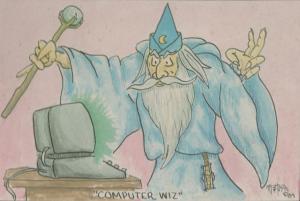
And the Jargon File has a story that I think captures something of the hackerish attitude. This comes from Guy L. Steele, Jr., who was also a well-known hacker, who wrote a definitive book on Common LISP and worked on the Java specification.[Raymond & Steele]
A Story About `Magic’: (by GLS)
Some years ago, I was snooping around in the cabinets that housed the MIT AI Lab’s PDP-10, and noticed a little switch glued to the frame of one cabinet. It was obviously a homebrew job, added by one of the lab’s hardware hackers (no one knows who).
You don’t touch an unknown switch on a computer without knowing what it does, because you might crash the computer. The switch was labeled in a most unhelpful way. It had two positions, and scrawled in pencil on the metal switch body were the words `magic’ and `more magic’. The switch was in the `more magic’ position.
I called another hacker over to look at it. He had never seen the switch before either. Closer examination revealed that the switch had only one wire running to it! The other end of the wire did disappear into the maze of wires inside the computer, but it’s a basic fact of electricity that a switch can’t do anything unless there are two wires connected to it. This switch had a wire connected on one side and no wire on its other side.
It was clear that this switch was someone’s idea of a silly joke. Convinced by our reasoning that the switch was inoperative, we flipped it. The computer instantly crashed.
Imagine our utter astonishment. We wrote it off as coincidence, but nevertheless restored the switch to the `more magic’ position before reviving the computer.
A year later, I told this story to yet another hacker, David Moon as I recall. He clearly doubted my sanity, or suspected me of a supernatural belief in the power of this switch, or perhaps thought I was fooling him with a bogus saga. To prove it to him, I showed him the very switch, still glued to the cabinet frame with only one wire connected to it, still in the `more magic’ position. We scrutinized the switch and its lone connection, and found that the other end of the wire, though connected to the computer wiring, was connected to a ground pin. That clearly made the switch doubly useless: not only was it electrically nonoperative, but it was connected to a place that couldn’t affect anything anyway. So we flipped the switch.
The computer promptly crashed.
This time we ran for Richard Greenblatt, a long-time MIT hacker, who was close at hand. He had never noticed the switch before, either. He inspected it, concluded it was useless, got some diagonal cutters and {dike}d it out. We then revived the computer and it has run fine ever since.
We still don’t know how the switch crashed the machine. There is a theory that some circuit near the ground pin was marginal, and flipping the switch changed the electrical capacitance enough to upset the circuit as millionth-of-a-second pulses went through it. But we’ll never know for sure; all we can really say is that the switch was {magic}.
I still have that switch in my basement. Maybe I’m silly, but I usually keep it set on `more magic’.
And from classic textbook “Structure and Interpretation of Computer Programs”, second edition — aka the wizard book because of its cover.[Abelson, Sussman, Sussman]
A computational process is indeed much like a sorcerer’s idea of a spirit. It cannot be seen or touched. It is not composed of matter at all. However, it is very real. It can perform intellectual work. It can answer questions. It can affect the world by disbursing money at a bank or by controlling a robot arm in a factory. The programs we use to conjure processes are like a sorcerer’s spells. They are carefully composed from symbolic expressions in arcane and esoteric programming languages that prescribe the tasks we want our processes to perform.
A computational process, in a correctly working computer, executes programs precisely and accurately. Thus, like the sorcerer’s apprentice, novice programmers must learn to understand and to anticipate the consequences of their conjuring. Even small errors (usually called bugs or glitches) in programs can have complex and unanticipated consequences.
So that’s about where I walked in to all this.
One of the earliest print uses of the word “technopagan” I can find is a story by Erik Davis in the July 1995 issue of Wired magazine. The story is centered on Mark Pesce, a Bay Area software developer who was one of the creators of VRML, the Virtual Reality Modeling Language — sort of an early Metaverse attempt.
Davis describes techno paganismas “a small but vital subculture of digital savants who keep one foot in the emerging technosphere and one foot in the wild and woolly world of Paganism.” This being the mid-90s he also has to define Paganism for his readers (an “anarchic, earthy, celebratory spiritual movement that attempts to reboot the magic, myths, and gods of Europe’s pre-Christian people”) and notes:
A startling number of Pagans work and play in technical fields, as sysops, computer programmers, and network engineers. On the surface, technopagans like Pesce embody quite a contradiction: they are Dionysian nature worshippers who embrace the Apollonian artifice of logical machines. But Pagans are also magic users, and they know that the Western magical tradition has more to give a Wired world than the occasional product name or the background material for yet another hack-and-slash game. Magic is the science of the imagination, the art of engineering consciousness and discovering the virtual forces that connect the body-mind with the physical world. And technopagans suspect that these occult Old Ways can provide some handy tools and tactics in our dizzying digital environment of intelligent agents, visual databases, and online MUDs and MOOs.
“Both cyberspace and magical space are purely manifest in the imagination,” Pesce says as he sips java at a crêperie in San Francisco’s Mission district. “Both spaces are entirely constructed by your thoughts and beliefs.”
….
Besides whatever technical inspiration they can draw from magical lore, technopagans are driven by an even more basic desire: to honor technology as part of the circle of human life, a life that for Pagans is already divine.
….
The alchemists, healers, and astrological astronomers of old did their science in the context of sacred imagination, a context that was stripped away by the Enlightenment’s emphasis on detached rationalism. Today, in the silicon crucible of computer culture, digital denizens are once again building bridges between logic and fantasy, math and myth, the inner and the outer worlds. Technopagans, for all their New Age kitsch and bohemian brouhaha, are taking the spiritual potential of this postmodern fusion seriously. As VR designer Brenda Laurel put it in an in e-mail interview, “Pagan spirituality on the Net combines the decentralizing force that characterizes the current stage in human development, the revitalizing power of spiritual practice, and the evolutionary potential of technology. Revitalizing our use of technology through spiritual practice is an excellent way to create more of those evolutionary contexts and to unleash the alchemical power of it all.”
That article may have been the first use of the term to refer to actual professional technologists who are also Pagans. There seems to have been a 1992 Technopagan festival, I’ll be looking for more information about that.
Now, a different slant appears in Douglas Rushkoff’s 1994 book “Cyberia: Life in the Trenches of Hyperspace”[Rushkoff] and Mark Dery’s 1996 book “Escape Velocity: Cyberculture at the End of the Century”[Dery], focusing more on New Age types and performance artists like Thee Temple ov Psychick Youth, a group of chaos magickians who have been described by critics as moving from satirizing abusive cults to becoming one.[Siepmann]
And it shows up two years later in a 1997 episode of Buffy the Vampire Slayer (“I Robot, You Jane”) — I figure after that point it’s loose in the world.
Also our friends in ADF have a Technopagan SIG (Special Interest Group), not sure how long that’s been around — anyone? anyone?
Dery also mentions “mind machines”, which were a fad for a while around that time, they’re still around but I haven’t seen them hyped in a while.
They were an interesting bit of techno-magick, google/headphone combinations that claim to invoke trance states with flashing lights and rhythmic sounds. Dery quotes marketing copy for one, calling it the “new shamanic technology”, and comparing it to the fire circle: “Goggles with flickering solid-state lights provide the ‘firelight’, and digital stereo synthesized sounds create the ‘drumming.'”[Dery 58] Let’s note what a time capsule the word “solid-state” is… But also note what they choose to compare themselves too, that magic of the Fire Circle.
I remember a demo of some of these mind machines at one of the first Starwoods I attended in the early 2000s — I think Joe Rothenberg ran it. I tried one and found that it was okay, I’d play with one again, but I far prefer an actual Fire Circle.
But beyond that, Dery has an important point here. He points out that trying to validate religious or mystical beliefs or practices by borrowing terms or models from science, ends up re-enforcing cultural power of science. But…
But as technopaganism makes clear, there is more to this story than the desire for cultural accreditation. For those in neopagan or New Age subcultures who reject the anittechnology bias tradtionally associated with such beliefs, their relationship to science and technology has less to do with a longing for legitimation and more to do with William Gibson’s maxim “THE STREET FINDS ITS OWN USES FOR THINGS.” Their willful “misuse” of scientific concepts and digital technology in the service of the spiritual, the intuitive, and the irrational parallels, to a degree, the subversions of the outlaw hacker. (Tellingly, one Tools for Exploration catalog refers to mind machine hackers as “consciousness hackers.”)[Dery, 59]
Dery claims that this redirection of science and technology to unscientific ends is at the heart of technopaganism, and speaks to the need to make spiritual practices relevant to a technological society.
Cyberpunk
“The street finds its own uses for things” is a line from William Gibson’s cyberpunk short story Burning Chrome (published in 1982 by Omni magazine — anyone remember Omni? Very late 70s/eary 80s vibe, it took as its mandate “an original if not controversial mixture of science fact, fiction, fantasy and the paranormal.” My dad buying it, is probably part of how I ended up here…) Gibson later expanded on that in an essay titled “Rocket Radio” published in 1989:
The Street finds its own uses for things—uses the manufacturers never imagined. The microcassette recorder, originally intended for on-the-jump executive dictation, becomes the revolutionary medium of magnitizdat, allowing the covert spread of suppressed political speeches in Poland and China. The beeper and the cellular telephone become tools in an increasingly competitive market in illicit drugs. Other technological artifacts unexpectedly become means of communication, either through opportunity or necessity. The aerosol can gives birth to the urban graffiti matrix. Soviet rockers press homemade flexi-discs out of used chest X rays.[Gibson, “Rocket”]
It’s a very Discordian notion, isn’t it? You think you’re putting some little bit of order into the world, but the world has more chaotic ideas. Hail Eris!
Gibson is the guy who popularized the word “cyberspace” in his first novel, Neuromancer, in 1984. It’s sort of a heist novel where the goal is to allow two AIs to access each other and merge.
The sequel, Count Zero, is more interesting for our purposes. The joined AIs fracture, and appear in cyberspace as Vodou loas. Legba is specifically identified as “loa of communication, “the master of roads and pathways.” When the story’s hacker protagonist survives an encounter with “black ice”, lethal security software, it’s said that he is blessed by Legba.
Gibson’s interest in the intersection of Vodou with tech was based on noting a parallel between electronic circuit diagrams traces, and the veves, the symbols of the loa.
I want to mention another cyberpunk classic: Vernor Vinge’s True Names, a novella first published in 1981. Vinge says of this story,
One night [in 1979] I was working at home, logged on my school’s principle computer (a PDP-11/45 running RSTS…wow)! As usual, I sneaked around in anonymous accounts–no need for the whole world to see I was on the machine. Every so often, I’d take a look at the other users, or surface in my official account. Suddenly I was accosted by another user via the TALK program (which for some reason I had left enabled). The TALKer claimed some implausible name, and I responded in kind. We chatted for a bit, each trying to figure out the other’s true name. Finally I had to give up, and told the other fellow I had to go–that I was actually a personality simulator, and that if I kept talking my artificial nature would become obvious.
Afterwards, I realized that I had just lived a science fiction story, at least by the standards of my childhood. For several years (ever since reading Ursula K. LeGuin’s A Wizard of Earthsea) I’d had the idea that the “true names” of fantasy were like object ID numbers from a big database. Now I saw how easily that could be turned into a story.[Vinge 48]
In True Names, an AI project gets out of control and the government has to turn to underground hackers — “warlocks”, who access cyberspace though fantasy-themed virtual reality — to stop it. But at the end of the story, one of the aging warlocks is using the AI’s kernel to upload herself into the network, and will effectively become a god.
This is what Vinge refers to as the Singularity: either Artificial Intelligence or Intelligence Amplification results in the creation of a superhuman entity:
When this happens, human history will have reached a kind of singularity–a place where extrapolation breaks down and new models must be applied–and the world will pass beyond our understanding. In one form or another this Singularity haunts many science-fiction writers. A bright fellow like Mark Twain could predict television, but such extrapolation is forever beyond–say–a dog. The best we writers can do is creep up on the Singularity, and hang ten at its edge.[Vinge, 47]
Now a lot of folks envision the Singularity as something that’s going to be like the Rapture, a sudden thing that will end the world and send some to eternal bliss and leave others behind to suffer. But it occurs to me that the sort of Singularity has happened twice before, and that we’re in the midst of a third one.
The first singularity was when humans developed complex language. Suddenly these naked apes weren’t limited to the brainpower of one animal, they could connect their brains to others within a range of a couple of meters. That’s a whole new game — “behavioral modernity”, the archaeologists call it. There’s a lot of disagreement about just how and when that happened, but I think it’s safe to claim that it was one hell of a change.
The second was the development of writing. Now these dangerous little primates were no longer limited to connecting their brains to each other at short distance, but they could connect in a one-to-one or one-to-many manner — and across time.
The third is mass communication and intelligence amplification. We can communicate many-to-many, starting with that old printing press and developing to social media; and thanks to printing at first, and now the web, people have come to have access to an amount of information undreamed of in ancient times.
Now, we still have that old problem that information is not knowledge…conspiracy theories and the like are still information, technically speaking. (Information theory makes no distinction between “good information” and “misinformation”.)
Tech Gods
So we’ve been talking about magic and tech, but if we’re not just techo-wizards or technomages (a term from the science fiction series Babylon 5, in 1994) but techno-Pagans, we might ask about how and where the gods (in whatever sense you understand that idea) fit in here.
If we’re going to do a ritual that’s connected with technology in some way, if we want to do a blessing of the smartphones (as Selena Fox mentioned yesterday) or give thanks for a good network connection, what deities might we work with?
The internet dates only to the late 1960s at earliest, depending on how we count. Certainly no ancient cultures had any patron deities of the internet.
We might invent or discover or have revealed to us some new gods. Neil Gaiman’s novel American Gods gives us a fictional idea of some new gods for tech but they’re not really attractive, the antagonists of the story.
But our understanding of the gods has always evolved; old gods assume new roles.
We already mentioned Papa Legba. He is the master of roads, the intermediary between the worlds. He is usually the first to be invoked in ceremonies, because he opens the way between humans and the spirit world.
He is said to speak all languages, and so facilitates communication and understanding. But he is also a trickster, a not-always-reliable source of information.
Now…does this begin to sound a bit like the internet?
And speaking of tricksters…
Surely no human invention has done as much to bring chaos into the world as the stored program digital computer. So it’s not a coincidence that Discordianism has always had a following in hacker culture; I would see references to the Paratheo-Anametamystikhood of Eris Esoteric in people’s .signature files on USENET back in the day.
For those not familiar, a brief summary: Around 1958, Gregory Hill (aka Malaclypse The Younger, or Mal-2, among other names) and Kerry Thornley (Lord Omar Khayyam Ravenhurst, among other names) and their friend Bob Newport (aka Rev. Hypocrates Magoun) made up their own secret club. As boys will do. (I guess girls too, but having never been a girl I can’t testify about that.)
But unlike most boy’s secret clubs, theirs was founded on a weird and esoteric idea: chaos and disorder is not inherently a bad thing, but can be a source of creative power. It became a counter-cultural staple.
Discordianism’s main literary work is the Principia Discordia, which was printed with a “All Rights Reversed – Reprint what you like” notice, an early experiment in “copyleft” which may have influenced the Free Software movement.
So let’s have a “Hail Eris!” for the goddess who has made me her plaything over the years…
On a more serious note, we have deities of knowledge. For example: Saraswati — cited as “the Goddess of arts, crafts and technology” in a recent blog post at the Times of India[Bhattacharyya], so that’s not just a white American take)
Thoth, the Egyptian god of writing, magic, and wisdom — obviously that’s more speculative as we don’t have any ancient Egyptians to ask.
Hermes, like Legba a trickster and a messenger, a god of roads…also of commerce and sex, and given the use of the ‘net for e-commence and porn, seems like he’s got a place here… (And we’re not even getting into the Heremetic tradition here, where you’ve got a different take on Heremes, syncretized with Thoth.)
We also have gods of craft — being close to Imbolc we’ve been talking a lot this weekend about Brigid, whose domain includes both smithing and poetry. Feels like software might sit at that intersection, but maybe that’s just me.
So we could maybe think about connecting with these deities to help us use technology in a wiser way; I’ll be curious to hear your thoughts on that in a few minutes.
Tech in Ritual and Spellwork
But I want to wrap up my remarks with some ideas on how tech can influence our Paganism.
On the one hand, as Pagans we’re often seeking to strip away artifice and get down to something primal, something wild. On the other, human societies have always used the their available tech in ritual. And a lot of what we consider “primal” would be advanced technology to past societies. That steel athame is very much the product of artifice.
So I don’t think we need to be shy about using ritual tools that are enhanced with modern tech. For example, one vendor at Starwood last year had some very nice staffs enhanced with computer-controlled lights.
And of course in these past few years we’re become acquainted with telepresence for ritual.
Both Ian Corrigan and Selena Fox make reference to LED candles in their talks yesterday, and it reminded me of a little bit of ritual using them in a Zoom meeting last year, at the on-line convention for the AOBTA, the professional organization for Asian Bodywork Therapy. They were able to do a “pass the flame” ritual, by having one speaker reach their lit candle out to their right side, out of frame; and the next speaker reach to their left and pull their lit candle into frame. A very simple bit of special effects used in ritual.
So in summary: if it is our job to build a religious framework suitable for the next phase of human existence, as we move from an agricultural species to a technological one, our toolbox should reach back to the most primal elements — fire, drumming, all that good stuff. But we should also be open to the use of new tools and technologies in our work — and also seek to guide their wise use in broader society.
The street finds its own uses for things. And so does magick.
And I’ll end my remarks with a poem by Richard Brautigan. Now, it’s remarkable that a lot of people today think that this poem had to have been meant ironically, but Brautigan was Poet-in-Residence at Caltech, he wasn’t a technophobe. This poem’s captures a feeling of possibility that was present 55 years ago, and that maybe we can work to restore.
All Watched Over By Machines Of Loving Grace
I like to think (and
the sooner the better!)
of a cybernetic meadow
where mammals and computers
live together in mutually
programming harmony
like pure water
touching clear sky.I like to think
(right now, please!)
of a cybernetic forest
filled with pines and electronics
where deer stroll peacefully
past computers
as if they were flowers
with spinning blossoms.I like to think
(it has to be!)
of a cybernetic ecology
where we are free of our labors
and joined back to nature,
returned to our mammal
brothers and sisters,
and all watched over
by machines of loving grace.
References
Abelson, Harold, Sussman, Gerald Jay, with Sussman, Julie. Structure and Interpretation, of Computer Programs, 2nd ed. MIT Press, https://mitpress.mit.edu/sites/default/files/sicp/full-text/book/book.html
Adler, Margot. Drawing down the moon. New York, N.Y: Penguin/Arkana, 1997.
Bhattacharyya, Kamal [@herbinger, timesofindia.indiatimes.com]. “The relevance of Ma Saraswati in modern education” Reader’s Blog by The Times of India, 8 Feb 2022. https://timesofindia.indiatimes.com/readersblog/herbinger/the-relevance-of-ma-saraswati-in-modern-education-41142/
Campbell, Joseph. The Flight of the Wild Gander. New York, N.Y: HarperPerennial, 1990.
Charle, Alethea. “Medieval Manuscript Production:Scribes, Illuminators and Their Methods of Work” https://web.archive.org/web/20211005210153/https://thalesandfriends.org/wp-content/uploads/2012/03/manuscript_production-ENG.pdf
Davis, Erik. “Technopagans.” Wired, July 1995. https://web.archive.org/web/20081120211437/http://www.techgnosis.com/index_technopagans.html – https://www.wired.com/1995/07/technopagans/
Dery, Mark. “Escape Velocity: Cyberculture at the End of the Century.” New York: Grove Press, 1996. https://books.google.com/books?id=gJ0IMQWMVpYC
Elk, Black, and John G. Neihardt. Black Elk Speaks : being the life story of a holy man of the Oglala Sioux. Lincoln: University of Nebraska Press, 1988.
Gibson, William. Count Zero. New York: Ace Science Fiction, 1987.
Gibson, William. “Rocket Radio.” Vice. 2012 Apr 5. https://web.archive.org/web/20201130215521/https://www.vice.com/en/article/qkkmxx/essential-reading-rocket-radio (Originally published in Rolling Stone, 1989.)
Greer, Thomas. A Brief History of the Western World. Stamford: Thomson Learning, 1987.
Hafner, Katie. “The Epic Saga of The Well”. Wired . 1 May 1997. https://www.wired.com/1997/05/ff-well/
Hutton, Ronald. The Triumph of the Moon. Oxford, Oxfordshire: Oxford University Press, 1999.
Krippner, Stanley. “Conflicting perspectives on shamans and shamanism: Points and counterpoints.” Am Psychol. 2002 Nov;57(11):962-78. American Psychologist, Vol 57(11), Nov 2002, 962-977. http://dx.doi.org/10.1037/0003-066X.57.11.962, http://stanleykrippner.weebly.com/conflicting-perspectives.html
Malkin, G. and LaQuey Parker, T. “Internet Users’ Glossary.” (RFC 1392). Internet Engineering Task Force. https://datatracker.ietf.org/doc/html/rfc1392
Raymond, Eric S. “Dancing With the Gods”. https://web.archive.org/web/20211212021310/http://catb.org/~esr/writings/dancing.html
Raymond, Eric S. “Frequently Asked Questions about Neopaganism” [Archive-name: neopaganism-faq, Last-update: Samhain 1992, Version: 4.0]. https://web.archive.org/web/20210519031832/https://catb.org/~esr/faqs/paganism.txt
Raymond, Eric S., and Steele, Guy L. “The Jargon File, Version 2.9.10, 01 Jul 1992”. https://www.gutenberg.org/ebooks/38
Rushkoff, Douglas. “Cyberia : Life in the Trenches of Hyperspace.” San Francisco: HarperSanFrancisco, 1995. https://archive.org/details/cyberialifeintre00rush
Russell, Ben. “In pursuit of power”. Science Museum: Stories from the stores https://blog.sciencemuseum.org.uk/a-new-age/
Siepmann, Dan. “Groupthink and Other Painful Reflections on Thee Temple ov Psychick Youth.” PopMatters, 27 September 2019. https://www.popmatters.com/genesis-p-orridge-groupthink-2640631583.html
Vinge, Vernor. True Names…and Other Dangers. New York: Baen Books, 1987.
Whipps, Heather. “How Gutenberg Changed the World.” LiveScience. https://www.livescience.com/2569-gutenberg-changed-world.html


